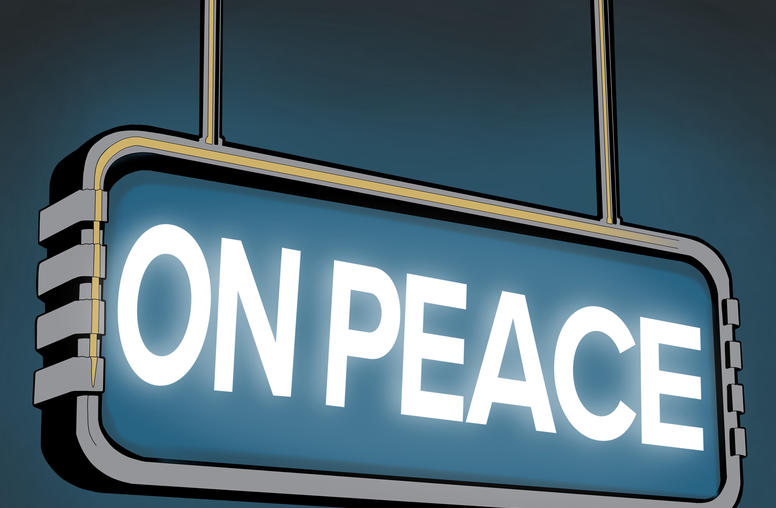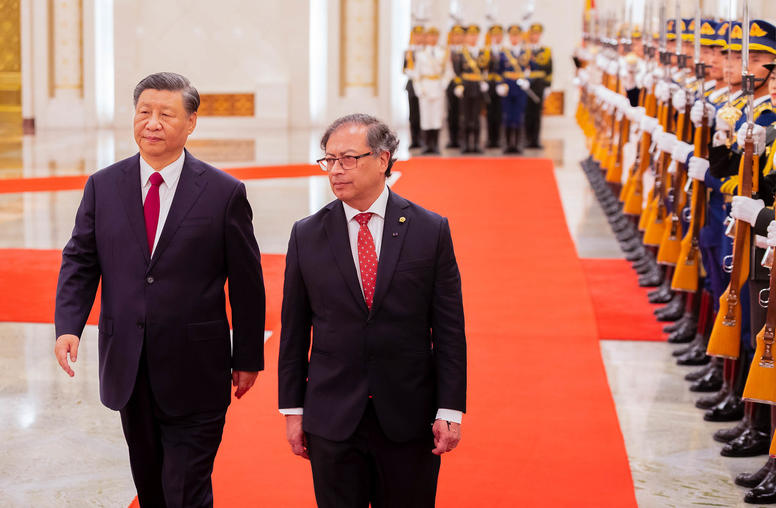Colombia’s Imperfect Peace Could Provide a Roadmap for Afghanistan
After decades of conflict, Colombia reached peace with the FARC. What lessons can be drawn for the Afghan peace process?
The Afghan peace process was jumpstarted in September 2018 when President Trump appointed Ambassador Zalmay Khalilzad as special representative for Afghanistan reconciliation. Since then, Khalilzad has led 10 rounds of U.S.-Taliban talks, with negotiations focusing on two issues: ensuring the Taliban’s commitment to prevent transnational terrorists from using Afghanistan as a base for attacks, and a U.S. military withdrawal. As the search for peace in Afghanistan continues, what lessons can be learned from other peace processes that could apply to Afghanistan? Colombia’s imperfect peace agreement with the FARC is one especially relevant international reference point for Afghanistan—we explain why.

President Trump paused the talks in September 2019 after a Taliban attack killed an American serviceman, but they have resumed in recent weeks and the Taliban have reportedly offered to reduce violence for a brief period—although the contours of that offer remain murky. Still, this has renewed hope that a U.S.-Taliban deal is imminent. Beyond the two issues that the U.S.-Taliban talks have focused on, two other key issues remain to be negotiated: a cease-fire and an intra-Afghan political settlement to be negotiated directly between the Taliban and Afghan government. This second component of the peace process design and structure is where Colombia’s process has the most relevance.
Colombia’s Progress on Peace
Like Afghanistan, Colombia was mired in conflict for decades. But, in 2016 after five years of direct negotiations, the Colombian government and Revolutionary Armed Forces of Colombia (FARC-EP) signed a historic peace agreement that sought to address the root causes of a 50-year conflict.
The negotiations provided a roadmap for a transformed and democratic Colombia, addressing inequalities in land rights, rural reform, illicit drugs, political participation, rights of victims, and the establishment of a comprehensive transitional justice mechanism. And, importantly, the negotiators identified a route to prevent a return to conflict through disarmament, demobilization and reintegration of former FARC combatants.
An October 2016 referendum put the agreement to the test with Colombian voters but failed to pass. After the referendum failed, negotiators returned to Havana to revise the FARC peace accord. In December 2016, Colombia’s Congress ratified the agreement and, a year later, Colombia’s Constitutional Court mandated a 12-year protection period for the accord. But it became clear the accord had been signed at a politically inopportune moment. The Santos administration had only one year left in office and 2017 was to be dominated by an election campaign that included very negative popular sentiment toward the agreement. The 2018 elections brought a change of administration with Iván Duque winning the presidential election, helped by his critical views of the peace process. This left many in the international community and Colombians wondering whether the agreement would be fully implemented or might fall apart altogether. There have been setbacks and implementation has been uneven—but progress toward peace has continued.
What Afghanistan Can Learn from Colombia’s Process
Colombia’s peace process has been hailed for its innovative approach, including: establishing a clear and specific objective (to end the war); beginning talks without a cease-fire in place; developing participatory mechanisms for various stakeholders; and openness in its approach to transitional justice. Many of these features of the Colombian process could be adapted to bring the Afghan government and Taliban to the negotiating table. Here are some lessons from the design of Colombia’s peace process that could apply to intra-Afghan talks.
Bring other countries into the process
Colombian negotiators carved out specific roles for the international community to support the process but not heavily influence the substance of the agreement, demonstrating Bogota’s seriousness in advancing a credible peace process that had regional support. Norway and Cuba became formal facilitators of the process. Norway often played a facilitative role during moments of stalemate, while Cuba hosted the two parties, provided logistical support, and organized delegation visits. Chile and Venezuela also provided regional support. The participation of neighboring countries can bring credibility to a peace process without tipping the scales to one side or the other.
The Afghan government and Taliban should consider such roles for neutral, regional countries and from allies further afield. Could Norway or Germany play a role as facilitator? What role could Pakistan play to support a durable peace? Could other countries like Qatar support logistics? Should Qatar continue to host talks? Will and should the U.S. play a role in the intra-Afghan process? These are some of the questions that architects of Afghan’s peace process should begin to answer. Afghanistan will undoubtedly need support once an agreement is reached—building relationships with observer countries can help guarantee such support.
Develop technical subcommittees
During negotiations with the FARC, subcommittees were formed so that if an impasse on an issue occurred, it wouldn’t lead to a total derailing of the process. Subcommittees generate trust between negotiating parties and facilitate momentum in a peace process. While Colombia ultimately established three subcommittees and two working groups, the subcommittees on gender and a cease-fire are the most applicable to an intra-Afghan process.
The subcommittee on gender was formed so that women could lend their expertise and review the agreement from a gender perspective—an unprecedented component of the process’ design. Delegates from both sides were aided by Colombian gender experts to support their review of the agreement and demonstrate how women had been affected by violence, how they could be allies in post-accord peacebuilding, and how establishing programs specifically designed for women could both positively and negatively affect themselves, their families and their livelihoods.
Afghanistan civil society could begin to generate knowledge, find outside experts and prepare technical expertise to facilitate discussions. Women, who are well organized and connected, could begin to collect information on technical issues and be prepared to feed that knowledge to a committee once a process begins.
Ensure inclusivity early in the process
While the Colombian process began as exclusive and elite, it became more inclusive over time. It is now lauded as one of the most inclusive processes because of the meaningful inclusion of women and marginalized voices. While the male-dominated negotiating delegations could have negatively impacted the advancement of women’s roles and rights, mounting pressure from civil society created the space for their proposals to be reviewed and integrated into the accord. Delegations of victims, many of which were women, visited Havana to demand recognition and admission of the harm inflicted by violence and to hold the negotiators accountable. They offered proposals and frameworks for a transitional justice model and focused their approach to justice through a restorative approach.
Women’s groups in Afghanistan have become one of the most organized constituencies demanding peace. Afghan women can hopefully ensure their participation by continuing to demand meaningful inclusion. Afghan civil society, particularly women’s groups, should recognize the many forms inclusion can take, including: direct representation; informal consultations; advocating for inclusive subcommittees; requesting delegation visits; monitoring the process and the implementation of the agreement; and campaigning for transparent decision making. Influence does not have to be achieved at the negotiating table alone. Instead, recognizing the different modalities for pushing forward inclusive agendas and voices can also shape a process. Afghan women’s contributions should also extend beyond gender issues. Their voices will be critical on issues like the role of democracy and justice sector reforms.
Carefully consider the ratification mechanism
One major lesson from the Colombian process is that putting an agreement to public vote can have negative consequences, even after a negotiating process hailed for its inclusivity. The 2016 referendum was intended to be a democratic instrument to bring in the public to affirm the agreement. While that was an entirely worthy endeavor, there were too many flaws in the lead up to the vote. There wasn’t enough time between the accord being signed and the vote to socialize the agreement. The Santos administration underestimated the spoilers that could sway voters. Conservative religious figures and churches, for example, led misinformation campaigns suggesting that the agreement would threaten traditional family roles.
As Afghanistan continues to build democratic institutions and values while holding deeply flawed elections, conducting a referendum on a peace agreement without appropriate mechanisms and means of communicating the details of how it can positively impact the lives of everyday Afghans is a recipe for failure. All stakeholders should be wary of how and through what mechanism the agreement is adopted to law. Afghanistan’s tradition of holding Loya Jirgas, where indirectly elected delegates from different parts of society decide on major matters of state, can be adapted to provide an inclusive but potentially more manageable ratification mechanism for peace.
Afghanistan has been in conflict for four decades, stretching back to the 1979 Soviet invasion. Many generations have come and gone during this conflict, and they are ready for the bloodshed and destruction to end. The decades to come should be for healing, building social cohesion, promoting co-existence, strengthening democratic values and rebuilding the country. Colombia’s peace process offers crucial lessons for Afghanistan to get there.


